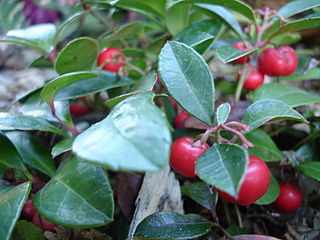
An achene is a type of simple dry fruit produced by many species of flowering plants. Achenes are monocarpellate and indehiscent. Achenes contain a single seed that nearly fills the pericarp, but does not adhere to it. In many species, what is called the "seed" is an achene, a fruit containing the seed. The seed-like appearance is owed to the hardening of the fruit wall (pericarp), which encloses the solitary seed so closely as to seem like a seed coat.

Gaultheria procumbens, also called the eastern teaberry, the checkerberry, the boxberry, or the American wintergreen, is a species of Gaultheria native to northeastern North America from Newfoundland west to southeastern Manitoba, and south to Alabama. It is a member of the Ericaceae.

Erythrina crista-galli, often known as the cockspur coral tree, is a flowering tree in the family Fabaceae, native to Argentina, Uruguay, southern Brazil and Paraguay. It is widely planted as a street or garden tree in other countries, notably in California. It is known by several common names within South America: ceibo, seíbo (Spanish), corticeira (Portuguese) and the more ambiguous bucaré, to name a few. Its specific epithet crista-galli means "cock's comb" in Latin.

Passerina is a genus in the plant family Thymelaeaceae. They are ericoid bushes growing largely in fynbos and other Southern African scrub habitats.

Billardiera is a genus of small vines and shrubs in the family, Pittosporaceae, which is endemic to Australia. The genus was first formally described in 1793 by botanist James Edward Smith who named it in honour of Jacques Labillardière, a French botanist.
Tetrachondra is a plant genus and a member of the family Tetrachondraceae. It comprises two species of creeping succulent, perennial, aquatic or semi-aquatic herbaceous plants. Its distribution range is disjunct: one species is endemic to New Zealand while the other one is endemic to southern Patagonia and Tierra del Fuego. These plants bear essential oils.

A prostrate shrub is a woody plant, most of the branches of which lie upon or just above the ground, rather than being held erect as are the branches of most trees and shrubs.

Lapeirousia is a genus in the plant family Iridaceae. It is endemic to sub-Saharan Africa, about a third of the species occurring in fynbos.

Struthiola is a genus of plants in the family Thymelaeaceae. In habit they are ericoid shrubs or shrublets.

Orphium is a plant genus in the Gentian family (Gentianaceae), endemic to South Africa. The name derives from the legendary Greek musician Orpheus. The genus contains a single accepted species, Orphium frutescens, commonly known as the sea rose. Orphium arenarium C.Presl has been proposed as another species, but data suggest that it is synonymous with Chironia arenaria E.Mey.

Nymania capensis is a species of plant known in English as "Chinese lantern" because of the shape of its bright, colourful fruit, and in Afrikaans as "klapper". It is the only species in the genus Nymania. It is a spare, scrubby, woody shrub or small tree, typically ) 0.5–3 m tall. It is endemic to South Africa and some closely bordering territories, especially inland regions in central, northern and eastern parts. It grows mainly in Karooid regions, among the scrub of gorges, but also in open veld and river banks in the Great and Little Karoo, Namaqualand and Kalahari. The leaves are alternate and fascicled. They are simple and more or less linear. The flowers are solitary, born on pedicels in axils. The corolla and calyx have four lobes each, with eight stamens inserted at the base of the disc, the filaments being connate at their base. The ovary is superior and sessile; it has four lobes and four locules, each containing two collateral ascending ovules. The stigma is simple and the style extends further than the stamens. The fruit is an inflated membranous capsule, 3–5 cm across, each locule forming a distinct lobe. The ripe seeds are hard and rounded, some 2–4 mm in diameter. A locule may contain less than two seeds, due to abortion.

Monopsis is a genus of small, Lobelia-like herbaceous plants indigenous to Africa. A few species are annuals, but most are perennials. Common names are not well established, but often refer to more familiar plants, as in "wild violet" for Monopsis unidentata, "yellow lobelia" for Monopsis lutea or "pansy lobelia" for Monopsis debilis.
Campylostachys is a genus of flowering plants in the family Stilbaceae described as a genus in 1832.

Kogelbergia is a genus of flowering plants in the family Stilbaceae described as a genus in 2000.

Veronica strictissima, the Banks Peninsula hebe, is a species of flowering plant in the family Plantaginaceae. It is only found on Banks Peninsula in New Zealand.

Paranomus abrotanifolius, commonly known as the Bredasdorp sceptre, is a richly branching shrub to 90 cm (35 in) high, with bisexual flowers that can be found from May to December, that is assigned to the protea family. It does not survive the periodic wild fires that occur in the fynbos, where it occurs. It is pollinated by insects. The fruits are ripe and release the seeds about two months after flowering, and the seeds are collected by ants, which take them to their underground nests to feed on their elaiosomes, a behaviour known as myrmecochory. This ensures that the seeds do not burn, so new plants can grow from them. It is a rare endemic species that is only known from ten locations near the southern coast of the Western Cape province of South Africa. It grows on weathered sandstone on the Potberg in De Hoop Nature Reserve and the Elim Flats.

Acacia scopulorum is a plant in the subgenus, Juliflorae, of the genus, Acacia in the family Fabaceae, endemic to the Northern Territory of Australia.















